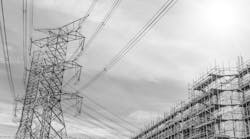Utilities Overcome Challenges with Technology-Driven PMO, Construction Oversight Services
Today, utilities are facing many grid modernization challenges. Some of the most pressing considerations surrounding electric utilities include upgrading transmission and distribution (T&D) lines, replacing antiquated substations, grid hardening for protection against natural disasters, and constructing greenfield T&D projects to meet the changing mix of a power generation portfolio and the ever-increasing growth in their service areas.
Challenges
The high demand for utility construction in Texas and around the United States has made it challenging to find enough qualified engineers, contractors, and construction oversight personnel to complete the work with highest quality safely and within allotted schedules. Moreover, schedules that involve transmission line and substation outages for construction projects must be submitted and approved by transmission grid management and the Electric Reliability Council of Texas (ERCOT) at least 120 days in advance.
These tight clearance windows and the high demand for contractors and construction oversight personnel in Texas and around the United States has created an environment where delays of any nature are devastating in terms of meeting project in-service dates within the allocated budget, and thereby pose a serious threat to the success of a project.
Many electric utilities also face project management organization (PMO) challenges in executing today's complex projects. Working with multiple remote teams, contractors, and suppliers located at diverse locations creates a challenging project management scenario. Utilities have come to realize that for successful project execution and meeting in-service dates, completion schedules, and safety goals, it is especially important to develop reliable project schedules and have a PMO track real-time information and support optimal coordination between geographically-dispersed project teams. Utility PMOs are looking for innovative ways to minimize delays and improve the overall coordination between safety, engineering, procurement, right of way, environmental, operations, and construction management.
Real-time reporting and informed decision-making are keys to success
A common and major component to the success of both PMO and construction oversight programs is real-time communication and documentation between the engineering team, operations and construction management team, and field personnel. A streamlined process through the use of innovative field reporting tools, technology for real-time project updates, artificial intelligence (AI) for business intelligence, and informed decision-making are worthy of consideration.
Issues related to rights of way, material management, engineering, safety, and construction progress must be relayed to appropriate levels of operations and management in real time. Revised engineering and manufacturer drawings need to be available to construction management and construction oversight personnel without delays and with appropriate document controls. As-built drawings must be delivered from the field in a timely manner and in a format that allows engineering to update prints efficiently and with a greater degree of confidence. Material management and reliable construction progress reporting are two main areas that utilities can improve.
Another critical piece that is often overlooked is data security. This is critical for individual privacy concerns as well as national security concerns when it comes to critical infrastructure industries like electric utilities.
Reliable information from construction oversight helps PMO succeed
Deficiencies in material should be reported quickly and clearly to avoid project delays. Construction progress should be delivered in such a way as to give a true overall view of a project. Progress reporting needs to be versatile to allow for quick interpretation at a high level yet detailed enough to give construction management, engineering, and PMO insight into trending construction and project issues by using AI and machine learning technologies.
For PMO, construction management, and material management teams, the typical challenges seen for utilities include communication of issues related to materials as well as those surrounding right of way and permits. Once identified, they should be reported back to the engineering and project management teams in real time.
Field teams need access to the latest documents and drawings with adequate document controls and getting updated as-built drawings from the field to engineers are common project execution challenges for most utilities. The overall objective of a construction oversight program is to provide field oversight and management of utilities' T&D and substation projects and provide reliable project progress updates and as-built information to PMO and engineering teams.
Changing expectations in construction oversight and PMO
Expectations for construction oversight and PMO programs are growing and evolving to meet today's technology- and AI-driven era. Utilities are emphasizing the importance of the combination of IT and the well-being of their workforce on their projects as a core component of a project's success. Utilities are focusing on accountability, reliability, and professionalism in the industry through productivity-enhancing software tools and AI that provide real-time project updates, project documentation, and predictive modeling. At the same time, utilities are laying a particular emphasis on the health, safety, and human performance of the workforce on their projects to ensure project success.
A combination of services and software products can provide these utilities with real-time project progress tracking and the ability to compare that with project schedules. Specialty software — which includes app-based mobile data collection in the field, an enterprise file share solution, business intelligence tools, and AI — that can report current activities as well as perform historical analysis and predictive modeling to provide actionable, real-time intelligence will aid in successful project execution.
Some of the features of the software tools that help in utility PMO and construction oversight program success include:
- Field data collection on any GPS-enabled smartphone or tablet
- Mobile forms for documenting field work, creating work requests, and performing quality checks
- Clean/concise email reports that include daily work activity summaries, marked-up photos, and map locations
- An enterprise file share solution for project documentation
- Data integration with Oracle Primavera P6, SAP, Excel spreadsheets, and field data collected
- AI and machine learning with a powerful set of web-based dashboards to view field activities, monitor work progress, perform historical analysis, and provide predictive modeling.
A simple-to-use, clear view of a utility's projects and the financial and schedule impacts of engineering, material, and construction issues help in overall program success.
Progress in the field can be tracked using field data collection mobile apps that directly feed the information into a business intelligence dashboard. Access to project documentation in the field is provided by an enterprise file share solution and project issues are communicated immediately to all relevant personnel with detailed documentation and marked-up photos from the field. Reporting is automated through emails, AI, and business intelligence dashboards, eliminating the administrative cost of report scanning, data input, and formatting. Real-time documentation also includes marked-up engineering plans and manufacturer drawings with identified issues and potential solutions. This technology facilitates a quick response to problems, limiting long remediation times and excessive costs.
Data security brings peace of mind to critical infrastructure industries
Utilities and other critical infrastructure industries prioritize data security, which is achieved in a multifaceted manner, beginning with security of logins and devices. At the individual level, logins must be strong. This along with multi-factor authentication (MFA) makes it difficult to breach security.
Security on devices must be enabled to ensure data can be remote wiped in case they are stolen or lost. Training in phishing awareness and digital data and asset protection is critical in the industry. This mandatory training emphasizes the need for protecting the proprietary data of utilities and critical infrastructure industries.
In addition, files must be encrypted and stored and must not be used without proper credentials. The data that resides in an app must be protected through logins to the devices as well as logins to the app where the data is stored. These are just a few measures to ensure data is highly secure yet available to our users when they need it.
Tech-enabled services, AI, health and safety, human performance bring results
Photos and documentation provided by the construction oversight personnel and supported in the app make the project teams like PMO, construction management, and engineering feel as though they are in the field with the construction crews. The tech used in the program ensures reporting consistency across all projects and dramatically increases the reliability, productivity, and the quality of deliverables of the PMO. This improves engineering and construction operations and provides actionable business intelligence for utilities. Qualified, experienced, and supervised construction oversight and PMO personnel with in-depth human performance training and focus on health and safety play a key role in a successful project.
Human performance is a work process that analyzes how actions can result in mistakes and how remediating behaviors can reduce or eliminate mistakes. Human performance principles help an individual maintain positive control of a work situation, ensuring that what is intended to happen is all that happens. All of this leads to improved decision-making and increased process efficiency, resulting in much smoother operations for utilities.
Tools make employees more efficient and effective in the field. These AI- and technology-driven PMO and construction oversight programs frequently result in an overall lower total cost of the program for utilities. Using information technology and AI, while having human capital trained in human performance and health and safety as the core of PMO and construction oversight programs, helps in overall project success for utilities.


